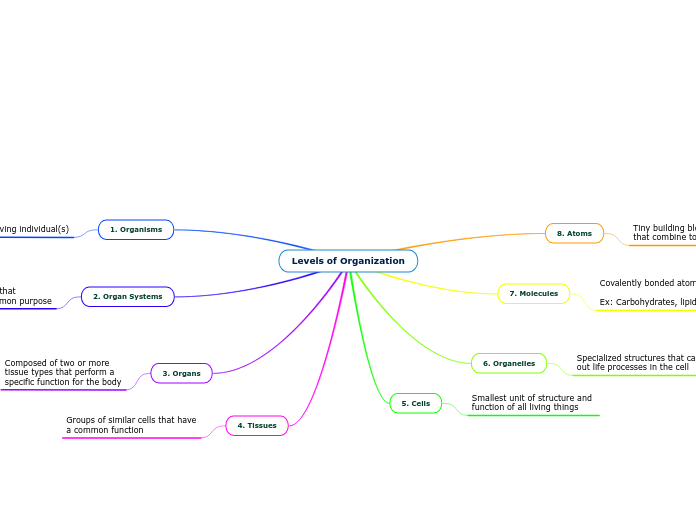BIOLOGY UNIT CONCEPT MAP ASSIGNMENT
Heirarchy in the Organization of living things
Importance of cells division
Cell division for
repair
A bone break, a cut, or blister all require
new cells to close the gaps.
Your body also replaces each red blood cell
every 120 days
Each day your body sheds millions of dead skin cells
Replaced by new ones
Cell division for growth
The movement of these chemicals are caused by diffusion
Concentration is the amount of solute (substance) in a given volume of solution
Osmosis is how water enters and leaves the cell
All organisms grow. As multicellular organisms
grow, the number of cells increases
The size of each cell does not increase because of
how a cell uses chemicals to function
Cells require: Energy, nutrients, water, and gases
Must also be able to excrete
carbon dioxide and other waste products.
Cell division for Reproduction
All cells use cell division to reproduce.
Each time a parent cell divides, it results in two new organisms.
Multicellular organisms also need to reproduce and pas their genetic information along to their offspring. (Some multicellular organisms can produce offspring by asexual reproduction.)
Sexual reproduction in which a cell from one parent
joins with the cell from another parent. These two parental cells are different from normal body cells: as they contain half of the DNA found in a cell.
Cells know as gametes undergo additional cell division prosses such as meiosis. (When two gametes combine.)
Offspring will inherit characteristics from both parents.
Each organisms inherits
genetic information from its
parent. It's important that each new cell has a complete set of genetic information
Asexual reproduction involves only one parent.
The offspring are exact genetic copies of the parent.
You start life as a sing cell: a fertilized egg. Now your body is made up of trillions of cells. For a single cell to become a full grown multicellular plant or animal Cell division is required as it allows organisms to reproduce, grow, and repair damage.
Cell
Life cycle
Cells
Animal cell Organelles
Plasmodesmata
Lysosome
Cell membrane only No cell wall
Cytoskeleton
Multiple small vacuoles
Centrosomes
Organelles
Mitochondrion
Cell Membrane
Nucleolus
Nucleus
Endoplasmic reticulum
Golgi apparatus
Vesicles
Vacuoles
Cytoplasm
Nuclear Membrane
Chromatin
Smooth ER
Rough ER
Ribosomes
Plant Cell Organelles
Chloroplast
Large vacuole
Cell wall
Smallest in the hierarchy of living things









